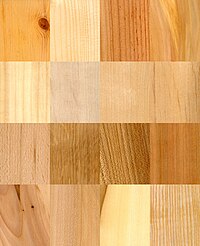
Photo from wikipedia
A broader utilization of wood can be achieved by eliminating its drawbacks such as low dimensional stability with changing moisture content and low durability against various bio-organisms. Heartwood formation is… Click to show full abstract
A broader utilization of wood can be achieved by eliminating its drawbacks such as low dimensional stability with changing moisture content and low durability against various bio-organisms. Heartwood formation is nature’s solution that functions through biosynthesis and accumulation of some phenolic compounds in the cell walls, leading to more durable and stable wood. In this study, a natural flavonoid molecule, chrysin, was used to improve Scots pine wood properties. Hydrophobic chrysin was impregnated into wood after a pre-treatment. The chrysin modification reduced the water uptake of the wood cell walls by up to 33% and increased the dimensional stability of the Scots pine by up to 30%. Infrared spectroscopic analysis revealed the chemical characterization of the bio-inspired modification. In contrast to the many modification methods that establish covalent bonds between hydroxyl groups of wood polymers, chrysin was bulked into wood cell walls and stabilized by intermolecular interactions.
Journal Title: BioResources
Year Published: 2019
Link to full text (if available)
Share on Social Media: Sign Up to like & get
recommendations!